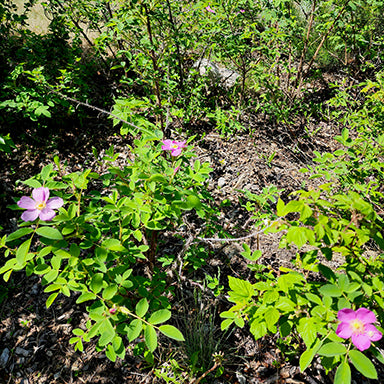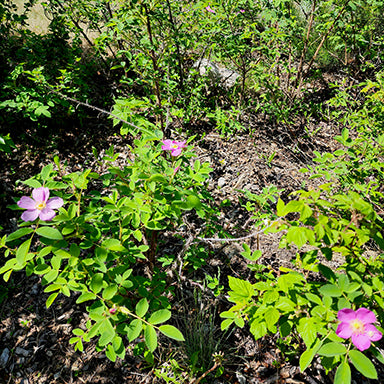Wild About Flowers
Rosa acicularis - Prickly Rose
Rosa acicularis - Prickly Rose
Couldn't load pickup availability
In late spring to early summer, Prickly Rose produces fragrant pink flowers that attract native bees, butterflies, and other pollinators. As the season progresses, bright red rose hips develop, serving as a critical winter food source for birds and wildlife. Its thorny stems provide natural shelter for small animals, while its deep green foliage turns to burnt shades of pink and red in fall, adding seasonal interest. This vigorous, fast-spreading shrub is best suited for larger rural landscapes, where it can grow and spread freely.
Adapted to a variety of soils, Prickly Rose spreads aggressively through rhizomes, making it ideal for erosion control, wildlife corridors, and self-sustaining, low-maintenance plantings in naturalized spaces. Mature plants are moderately deer-resistant due to their dense, thorny stems, though young shoots may be browsed.
Bloom Times & Plant Sizes
Bloom Times & Plant Sizes
Important Information - The "Bloom Period" is an indicator of the time period within which the wildflowers will bloom and does not describe the time period that a single plant will bloom. The "Sizes" listed are intended to be a general guideline to consult during plant selection. - Plant growth and bloom times will vary depending on geographical location & individual site conditions.
Edible & Medicinal Info Disclaimer
Edible & Medicinal Info Disclaimer
The Edible & Medicinal information on this site is for informational purposes only and should not be acted on without thorough research and professional guidance. We are not responsible for any adverse effects resulting from the use of or misidentification of plants.
Share

Plant Specifics
Seeds Per Pack
Seeds Per Package: 10
Light Conditions
- Sun
- Part Shade
Soil Conditions
- Well Drained
- Loam
- Moist
- Rich
- Clay
- Sandy
- Gravelly
- Dry
Height
- 12" - 24"
- 24" - 36"
- 36" - 48"
Width
- Spreading
Bloom Colour
- Pink
Month of Bloom
- June
- July
- August
Vigorousness
- Aggressive
- Very Aggressive
Deer Resistance
- Moderate
Features
- Birds
- Butterflies
- Bees
- Fragrant
- Long Bloom Time
- Berries
- Fall Color
- Rural Spaces
- Medicinal Properties
- Edible Parts
- Good in Containers
Chinook Exposure
- Fully Exposed
Distribution Info
Prickly Rose is widespread across Canada occurring in every province and territory with it's range extending into the northern U.S.. It grows in open forests, thickets, meadows, roadsides, and riparian areas, often forming dense colonies.
Traditional Edible & Medicinal Info
The rose hips of Rosa acicularis are edible, traditionally used by Indigenous peoples as a nutritious food source high in vitamin C, often consumed fresh, dried, or brewed into tea. Root and leaf decoctions were used for digestive ailments and colds, while the petals were sometimes used for mild teas. Though not toxic, the seeds inside the hips contain fine hairs that can cause digestive irritation if eaten raw.

